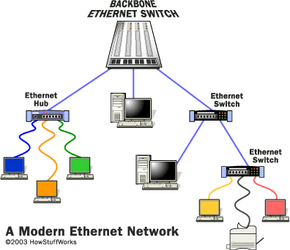Switched Ethernet
Modern Ethernet implementations often look nothing like their historical counterparts. Where long runs of coaxial cable provided attachments for multiple stations in legacy Ethernet, modern Ethernet networks use twisted pair wiring or fiber optics to connect stations in a radial pattern. Where legacy Ethernet networks transmitted data at 10 megabits per second (Mbps), modern networks can operate at 100 or even 1,000 Mbps!
Perhaps the most striking advancement in contemporary Ethernet networks is the use of switched Ethernet. Switched networks replace the shared medium of legacy Ethernet with a dedicated segment for each station. These segments connect to a switch, which acts much like an Ethernet bridge, but can connect many of these single station segments. Some switches today can support hundreds of dedicated segments. Since the only devices on the segments are the switch and the end station, the switch picks up every transmission before it reaches another node. The switch then forwards the frame over the appropriate segment, just like a bridge, but since any segment contains only a single node, the frame only reaches the intended recipient. This allows many conversations to occur simultaneously on a switched network. (See How LAN Switches work to learn more about switching technology.)
Advertisement
